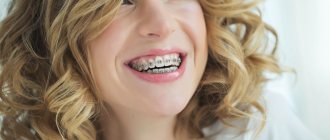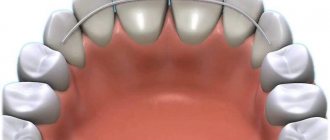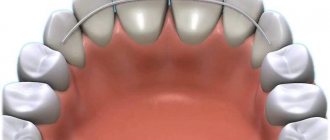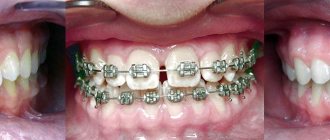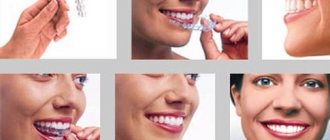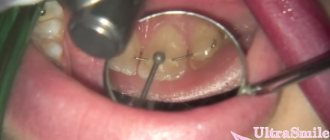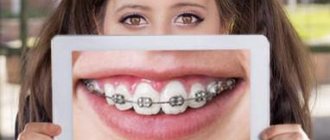Braces in the mouth cause certain inconveniences - not only physiological, but also psychological. It will take time to get used to them. In addition, a person's face may change after wearing braces. True, these changes are rather positive. What happens to the face during bite correction using braces?
In this article
- What consequences can there be from an incorrect bite?
- How to correct a malocclusion
- Mechanism of operation of orthodontic structures
- What happens to the face while wearing braces?
- How does the oval of the face change after braces?
- Do braces change your face forever?
- Oral care while wearing braces
Bite is the arrangement of the teeth of the upper and lower jaw relative to each other in a state of natural full closure. There are four types of correct bite that can be easily determined by your dentist. The teeth may be closed evenly, and the upper or lower teeth may be slightly pushed forward, generally without abnormalities. But there are five types of malocclusions; braces are used to correct them.
With an incorrect bite, the upper or lower jaw may be too forward, or if the jaw is closed, the teeth may be arranged crosswise, like scissors. With an open bite, they do not close completely; a large gap remains between the cutting edges.
What consequences can there be from an incorrect bite?
An incorrect bite negatively affects a person’s health if it is not corrected in time. Abrasion of the tooth edges may occur, and diction may be impaired. Pieces of food get stuck in the spaces between improperly growing teeth, and this is a direct path to the development of caries.
In addition to physiological problems, changes in the oval of the face also occur due to malocclusion. Due to the displacement of the lower jaw, horizontal asymmetry, hollowing or sagging of the cheeks may occur. The line of the mouth also changes - the corners of the lips droop, they become thinner, and do not close completely. The face is changing, and only clinical intervention will save the situation.
Real changes in patients' appearance
In fact, many patients note in their reviews that after wearing braces their heavy chin disappeared and positive changes occurred in their appearance.
After correcting the bite with braces, the shape of the skull and the oval of the face often change. Many patients are only happy about such good changes in their appearance.
Changes in the joint entail a change in the shape of the face. After the result is fixed, the joint remains deformed. If treatment is still ongoing, such changes may be temporary.
But if the patient wears braces to secure the result, then there is a chance that the joint will remain the same and the face will no longer change. Many specialists hide from their patients the fact that the shape of their face will be slightly changed after correcting malocclusions.
It is important to know: the face undergoes changes not because of braces, but because of the maxillofacial joint; any changes in the bite or jaw expansion entail changes in the shape of this important joint.
For them, beauty and aesthetics are an absolutely straight set of teeth. After removing braces, the oval shape of your face may become more elongated, and your cheeks will appear slightly sunken.
You might also be interested in an article about how to straighten teeth without braces.
Read the article about Incognito braces here.
You may also find this article about proper bite helpful.
How to correct a malocclusion
In orthodontics, there are a number of methods that help correct this jaw pathology. The most common of these are braces. They effectively correct malocclusion and dental imperfections. But wearing them is associated with some issues that the patient needs to know about before starting the correction.
Firstly, you need to prepare yourself psychologically that you will now have to wear a non-removable appliance on your teeth for a long time (at least a year). With it you will have to acquire new habits for caring for the oral cavity, in addition, braces change the shape of your face. Why is this happening? To do this, you need to understand how braces work.
Photos of correcting crooked teeth in children
When milk teeth are removed early, the teeth behind them move forward, to the place of the removed ones, and occupy a “foreign” place. In this case, the primary canine was lost prematurely; its place was completely covered by the teeth behind it, thereby completely “taking” the place from the permanent canine. Fortunately, the orthodontist managed, with the help of a removable appliance, to move the entire segment posteriorly and get a place for the fang!) It didn’t take long to wait and soon erupted into the oral cavity! Of course, the work is not finished yet, but most of it is done!
Mechanism of operation of orthodontic structures
Each bracket is fixed to the crown and rotated in the desired plane to rotate and correct the position of the tooth in the row. Braces are made according to an impression of the patient’s jaw, taking into account all individual characteristics. Metal arches put pressure on the crowns, the periodontal ligaments are stretched, and the tooth gradually moves to the desired position. As it moves, the bone tissue is absorbed, and a new one is formed in the previous area.
In addition, other facial structures also change, since they are all connected together. This is why wearing braces inevitably changes the shape of your face.
Why is this leveling and treatment better than surgery?
Today, plastic surgery can correct any facial imperfections, both very minor and major. But any operation has a number of disadvantages:
- seams;
- long rehabilitation;
- possible side effects.
In addition to its main task, installing braces can also be used to harmonize the face. Moreover, often the result of treatment by an orthodontist can even surpass the work of a surgeon.
With the help of braces, you can get plump lips, pronounced cheekbones, and an improved cheek and chin line without having to go under the surgeon’s knife.
If you get braces, don't be afraid that they will change your face. Due to the deformation of his teeth, his features are already changed. Most often, along with a beautiful smile, installing the system makes it possible to obtain more harmonious and pleasant facial features. For those who wear braces, it is important to regularly visit a specialist and follow all his recommendations.
What happens to the face while wearing braces?
The extent to which braces can change the shape of the face depends on the degree of tooth deformation and the type of bite that needs to be corrected. The behavior of the patient himself is also important - how accurately he will comply with the orthodontist’s instructions.
When wearing braces, interrelated changes occur in the maxillofacial structures. As they say in this case, braces break the face. The gradual displacement of bone tissue affects the muscles - their tone increases or, conversely, decreases. Let's take a closer look at how individual facial structures change.
Proportional facial changes during orthodontic treatment
Braces have a complex effect on the dental system, which is connected to other bones of the skull and spine. Correction of pathological bite and elimination of deficiencies lead to changes in the shape and position of the jaws, the location of muscles and their tension. It also affects the elimination or movement (appearance of other) skin folds and fat deposits.
During the process of changing the bite, the teeth change their position, rotation and inclination. Normalization of the bite leads to a redistribution of the chewing load and the formation of new muscle habits, accordingly changing the face.
How does the oval of the face change after braces?
A common question before installing orthodontic structures is whether braces break the oval of the face? Yes, after wearing them, some changes in the shape of the cheekbones and cheeks are possible in some cases. How obvious the changes will be depends on the type and degree of pathology.
Cheeks
The way the overall shape of the face looks, of course, is greatly influenced by the cheeks. Usually, after using braces, they become more sunken, and this is due to the following reasons. The doctor removes the extreme “eights”, which almost always interfere with the correction of the bite. The second factor that affects hollow cheeks while wearing braces is a change in diet. The patient's menu now includes much more liquid food and fewer snacks.
But gradually the place of the removed outer teeth is filled with bone tissue, and the diet becomes more complete as you get used to the braces, and the cheeks can acquire their previous roundness.
Cheekbones
Typically, after braces are installed, cheekbones become more noticeable. This occurs due to some hollowing of the cheeks and changes in facial expressions. If earlier, when smiling, a person tried to hide his teeth by tensing the muscles near his lips, now other muscle structures begin to work.
Nose
How does the nose change after braces? Many people note its slight upturning when wearing vestibular braces on the upper jaw, which persists even after their removal. This occurs due to a slight displacement and restructuring of the cartilage tissue of the nose. But women even like such changes in their faces - a cute upturned nose gives them a special charm.
Chin
Whether the position of the chin will change while wearing braces depends on the initial defect: if before their installation it was moved forward, now it can move back. If the bite defects are insignificant, then there will be no special metamorphosis with the chin.
Lips
Do the lips on the face change when wearing braces? This question especially worries girls. In this case, they even receive a pleasant bonus: now there are arches and braces under the lips, and they become a little plumper. Isn't this what all women dream about? However, after the braces are removed, the effect disappears.
Will the face recover after braces are removed?
The process of normalizing the proportions of the jaws and teeth can change facial features. Usually they are not too pronounced, and most patients consider these changes for the better. We are talking about physiological transformations when the treatment is carried out professionally and successfully.
With a pronounced degree of deformation, as well as in the case of a not entirely successful correction, one cannot count on an independent aesthetic effect. And not all patients like their new appearance. Restoring your face after dental braces is not an easy task; it requires time, patience and perseverance.
For recovery, a combination of facial massage with face-building - special exercises for the chewing and facial muscles - has a good effect. It is better to entrust facial massage to a professional cosmetologist, and you can do gymnastics on your own. The most popular exercise is the “Angle of Youth”, which is presented in the video.
Do braces change your face forever?
Often, after removing braces, some experience disappointment when looking at their changed face in the mirror: it seems to them too narrow, and their cheekbones are noticeable. In fact, after braces, the face acquires its natural contours, becomes symmetrical and proportional: with a normal bite and teeth in their place. That is, a person sees in the mirror the appearance that he would have by nature if not for the existing pathology. Many see these changes as positive.
How does your face change after braces are removed? In general, it acquires its natural physiological form. Here are the changes a person may notice:
- the asymmetry of the oval of the face disappears;
- the lip line will become smoother;
- An overly heavy, protruding chin is reduced.
The question of how the face changes after braces can generally be answered in a positive way. With the restoration of the bite, the entire dental system begins to work correctly: the load on the muscles and ligaments is distributed evenly, which helps eliminate visual defects.
Correcting malocclusion is much easier in childhood and adolescence, when the bones of the face are not yet fully formed. But adjustments are also possible in adults, it just takes longer.
However, the problem should not be neglected and a visit to a specialist should not be delayed. The sooner orthodontic treatment is started, the faster its results will be achieved: you will get a symmetrical oval face and will be able to show off your beautiful smile without embarrassment.
Why does your face change after wearing braces?
The principle of operation of the braces system is that it gradually and forcibly moves the teeth in the required direction. Thanks to this process, you can correct the profile, correct the anomaly of an individual tooth or a whole row, and improve facial aesthetics. Already 8 months after wearing braces, the patient can notice how his face changes after braces.
Why do transformations occur?
- - increased tension, lengthening of ligaments;
- - decrease or increase in muscle tone;
- — transformation of bone tissue;
- - changes affecting subcutaneous tissue, fascia and the skin itself;
- — visual visibility of the bracket system itself.
The maxillofacial region is a single anatomical and functional system. If something changes in the bone structure, it is reflected in a person’s facial features. However, you should not assume that the changes will be as noticeable as after plastic surgery. In some patients, the transformation is practically not expressed, while in others it is too noticeable. Let us repeat that this is due to the nature and extent of the anomaly. At the initial consultation, our orthodontist will tell you about the features that may occur with your face, whether your face changes after wearing braces, and whether this may affect your particular case.
Transformations may also be due to the fact that the patient is forced to comply with certain dietary restrictions. In this regard, the face loses weight and the effect of “sunken” cheeks appears.
Oral care while wearing braces
It should be remembered that during this period, particularly careful oral hygiene is required. Braces are a non-removable structure, and pieces of food get stuck under them, which need to be removed in a timely manner. Regularly carefully clean the oral cavity and the braces system itself with a special brush every time after eating. While wearing braces, it is advisable to floss to remove food debris between the teeth and rinse them using an irrigator. If you neglect your oral care during this period, your teeth may develop caries.
Changes in appearance: minus to minus gives a plus
On numerous forums you can find negative feedback about the ongoing changes in the face: “the cheeks are sunken”, “the skin is sagging”, “the face has aged”, etc. As a rule, such reviews are typical for the first two months of treatment with vestibular and lingual braces. Negative consequences are indeed observed during this period. And they are caused by two reasons:
- removal of teeth that interfere with the correction of the dentition;
- installation of a sufficiently voluminous orthodontic system that has a certain weight, immediately changing the appearance visually.
As a result, in the first weeks of treatment, many women panic because they:
- the face narrows;
- nasolabial folds deepen;
- if the upper jaw becomes heavier, the chin becomes sharper, and if the lower jaw becomes heavier, the cheeks become sunken;
- With some pathologies, the lips begin to bulge and it becomes difficult to close them.
Fortunately, the negative consequences will go away very quickly with the beginning of visible treatment progress. And already in the third or fourth month, facial features will begin to change for the better. Let's take a closer look at this process.
Life after braces: a thinner face and expressive cheekbones
According to experts, malocclusions occur in approximately two-thirds of the population of the Russian Federation. It's no surprise that turnkey braces are becoming an increasingly popular service. In Moscow, you will no longer surprise anyone not only with classic metal braces, but also with replaceable aligners, which are less noticeable when you smile. They not only correct the bite, but also help correct the oval of the face. Therefore, by the time the treatment is completed, all patients receive an attractive smile, and the fair sex is additionally pleased with more clearly defined cheekbones and voluminous lips.
Changes in bite during treatment
To correct the bite in orthodontics, braces are used. Before installing plates on the teeth, the orthodontist thoroughly studies the anatomical features of the jaw and assesses the severity of the deformation. Before braces, most patients are embarrassed about their smile because a photo of their teeth looks unattractive.
Before correcting teeth with braces:
- the upper canines are knocked out of the general row, since they are cut last and do not fit in the remaining space;
- the front teeth protrude forward due to too narrow a space and overlap each other;
- there are large gaps between the incisors;
- the upper jaw in relation to the lower has a distorted anatomical position.
If you look at the photos before and after treatment, you can doubt the veracity of the result. The position of the jaw changes so dramatically that the patients’ faces become unrecognizable. However, straightening teeth only seems like a simple task. People experience month-to-month changes that are regularly assessed by an orthodontist.
The first changes with braces are noticeable after 2 months. However, wearing braces cannot be canceled at this point. The patient regularly visits the dentist to correct the position of the arch. It is she who creates pressure on the row and corrects its position.
Evenness appears gradually. The time required to completely correct the bite is determined individually. How long the structure will have to be worn depends on the initial condition, type of staples and age of the patient. Metal braces correct deformities faster than aesthetic ceramic or sapphire braces.
Types of malocclusions
Malocclusion negatively affects appearance; each of its varieties causes certain deformations of the face, violating its symmetry and proportionality:
- with a distal bite, the chin is visually reduced, slanted or pushed back, soft tissues sag even at a young age, the upper lip protrudes strongly forward, the corners of the lips are drooping;
- with a deep bite, the lower third of the face is shortened, which is why it appears flattened from below, the lower lip turns outward under the pressure of the upper;
- with a mesial bite, the lower jaw protrudes forward, which is why the chin looks too massive, “heavy”;
- with an open bite, the lips do not close, the mouth is constantly slightly open, the symmetry of the face is broken, the cheeks are sunken;
- With a cross bite, the jaws develop unevenly and shift relative to each other, causing asymmetry in the oval of the face and jawline.
Any type of abnormal bite is characterized by a violation of the chewing function, which leads to improper load on the facial muscles, causing facial features to be distorted.
